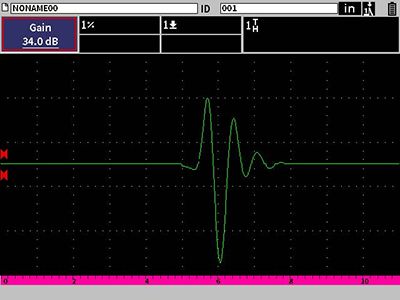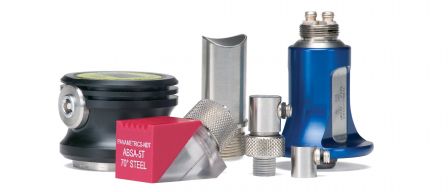Application
Using nondestructive testing to evaluate the integrity of bonds between dissimilar materials of low acoustic impedance and high acoustic impedance such as plastic, fiberglass, rubber or epoxy bonded to metal, glass, or ceramic.
Among the specific applications for this test are bonding of carbon/fiber/resin composites to a steel substrate, bonding of plastic liners in metal pipes and tanks, plastic safety coatings over glass, rubber coatings on metal rollers, and epoxy coatings on metal parts. The technique has also been used on metal bearings where soft, low impedance metal, such as babbit, is bonded over hard, high impedance metal (steel or brass).
Problem
The most common technique for using ultrasonic testing to evaluate the integrity of a bond or weld is to look at the amplitude of the signal reflected from the interface between the two materials. This method works well when the two joined materials have similar acoustic impedance, such as metal to metal or plastic to plastic. However, when the two bonded materials differ greatly in acoustic impedance, such as a plastic to metal bond, the change in the amplitude of reflected signals between good and bad bonds is less dramatic. In these cases, the most readily visible difference between bonds and disbonds is a reversal in the phase or polarity of the echo from the boundary when the bond is tested from the low impedance side pattern.
Equipment
This test may be performed with any ultrasonic instrument that provides an unrectified RF waveform display such as the EPOCH® 650 and EPOCH 6LT portable flaw detectors.Select the transducer type and frequency based on your specific application, but we typically recommend broadband transducers.
Procedure
Both the phase (or polarity) and amplitude of a reflected signal at the boundary between two materials are determined by the relative acoustic impedance of the two materials. The phase or polarity of the echo from the boundary between the materials is reversed or inverted when the order of relative acoustic impedances is reversed (low to high versus high to low).
Testing must be performed from the low impedance side of the bond. Also, it is important to note that this test identifies the presence or absence of an acoustic bond, but it does not quantify the strength of the bond.
Figures 1 and 2 show echoes from a plastic/air and plastic/metal boundary respectively, demonstrating phase inversion. These figures were produced using an EPOCH series flaw detector and V109 5 MHz broadband contact transducer.
Figure 1 shows the echo from the back side of a 0.2 in./5 mm flat piece of Plexiglas plastic, as seen by a 5 MHz broadband contact transducer with an EPOCH 650 flaw detector set up in the RF mode. In this case, the sound energy is reflecting from a boundary between a relatively high impedance material (plastic) and a very low impedance material (air). With this setup, the returning echo from this high to low impedance boundary is seen as a negative polarity echo.
Echo from unbonded Plexiglas plastic | Echo from Plexiglas plastic bonded to aluminum |
Note
Displayed echo polarity is arbitrary depending on signal processing within the instrument. While Olympus IMS flaw detectors and pulser/receivers produce displays of the type shown here,equipment from other manufacturers may display signals that are the reverse. A test block can help determine this factor. The basic principle of phase inversion at a low to high impedance boundary applies in any case.





